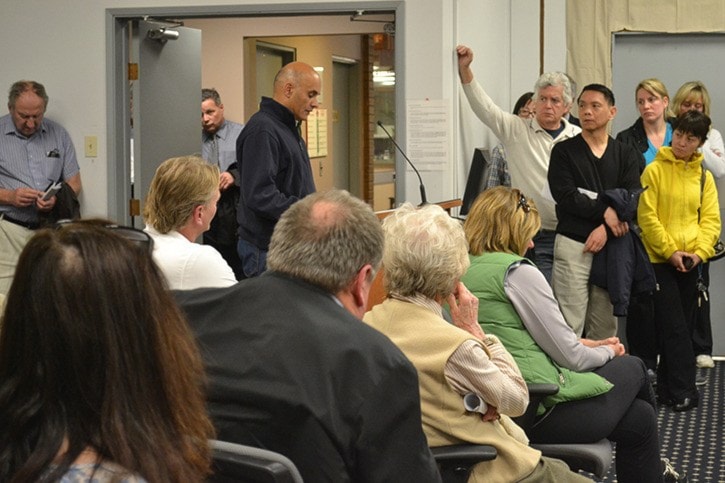Residents of White Rock’s West Beach poured into city hall Monday night to speak out against the lack of change in development restrictions in a proposed omnibus bylaw.
Dozens filed into council chambers for the public hearing on Bylaw 2000, drafted to update the current bylaw, which was adopted in 1999.
According to the city’s director of development services, Paul Stanton, the new bylaw aims to reflect changes to legislation and the city’s Official Community Plan.
However, the most contentious portion of it was a section for which no changes have been proposed.
In Bylaw 2000 – as with the current White Rock Zoning Bylaw No. 1591 – future developments in the West Beach area would have the starting point for building height based on the average natural grade on the lowest side of the building.
That method of measurement initially came into place in 2009, after the B.C. Supreme Court overturned a city decision to refuse a permit to residents Bob and Jacqueline Yearsley to build a six-storey building on their Victoria Avenue property.
Prior to the ruling, height measurements were based on the average natural grade of all four sides of proposed buildings, which allowed the Yearsleys to have a height boost on their sloping property, as the average natural grade set the zero point metres higher than the actual lowest point of the property.
Despite the change made in 2009 to make building heights more restrictive, residents who turned out Monday said they want the city to scrap the concept of measuring at a natural grade entirely, and instead base the measurement on existing grade.
Stanton warned such a move could lead to developers taking advantage of the bylaw.
“Measuring from existing grade is a moving target,” Stanton said.
“There’s nothing stopping (developers) from leveling the site at a much higher grade, which means they have a higher starting point if they are using existing grade. They will bring in the surveyor after they have leveled the building and leveled the site and say, ‘here are my existing grades, oops, they happen to be 10 feet higher than they were before.’”
Attendees were quick to contest the explanation, with some asking for an adjustment to stipulate that a development can be built on either existing or natural grade, whichever is lower.
Others disputed Stanton’s description of existing grade being a moving target.
“In my opinion – and I have quite a lot of experience with this, because I was an excavating contractor – the term ‘existing grade’ wasn’t wishy-washy. That’s what was stipulated and a contract was based on,” said George Taylor, a West Beach resident.
“The city should get a legal opinion on the term existing grade.”
The Yearsleys’ development, the Sausalito, was repeatedly pointed to as an example of how natural grade can result in higher developments.
In an email to Peace Arch News, Victoria Avenue resident Simon Bergen-Henengouwen noted that if a change is not made, another development could end up extending past the area’s height limit, essentially wiping out the views of current residents.
“We would like them to use the existing grade otherwise there will be a multitude of Sausalitos built up and down Marine Drive,” he writes.
Council is expected to vote on the bylaw at the next council meeting.
